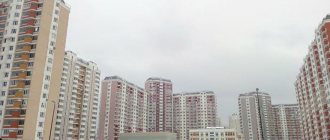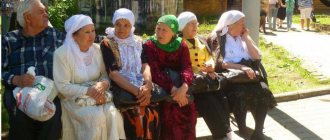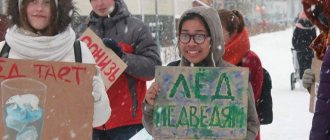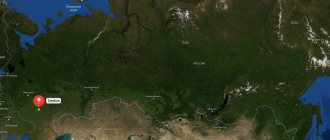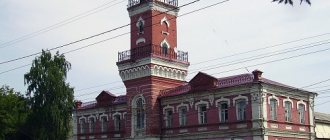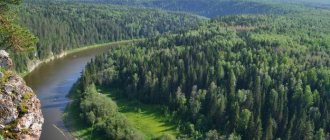Key information
The city is included in the list of settlements located in the Far North zone. Petrozavodsk is dominated by a temperate continental climate. The winter period is long and characterized by an abundance of snow. The average air temperature in the Prionezhsky region is +3 °C. The number of warm days exceeds 130. Cyclones are frequent guests in these parts. Air masses come from the west and bring with them heavy precipitation.
The hottest month is July. At the height of summer, the thermometer readings can reach +30 °C. The coldest time is January. The air temperature drops to -33 °C. The weather conditions in the region are directly influenced by the largest body of water in the Northwestern District. The city blocks are located on the shores of Lake Onega. The landscape of Petrozavodsk is cut by the beds of the rivers Tomitsa, Lososinka, Studenets, Neglinka. Some of them are navigable.
Flag
The flag of Petrozavodsk is made in the form of a rectangular white and blue cloth. The ratio of its sides is 2:3. The coat of arms is depicted in the upper left corner. Its width is 1/4 of the length of the flag. The height of the wavy blue stripe located at the bottom occupies 1/5 of the same size of the flag.
The composition was approved by decision of the Petrozavodsk City Council No. XXIV/IX-175 dated March 1, 2001.
Demographic statistics
The population of Petrozavodsk was first established in 1723. The number of residents at that time barely reached two thousand people. At the beginning of the 19th century, the city began to actively grow and develop. In 1801, almost five thousand lived there. In 1856 there were already more than 10,000 people. Until 1992, the population of Petrozavodsk was constantly increasing. In 1993, it amounted to 279,000. This year became a turning point for the demographic situation in the region.
The years in which growth was noted alternated with periods of natural decline. Thus, in 2001, the number of residents exceeded 282,900, and in 2002 it decreased to 266,160. The population of Petrozavodsk in 2009 reached 271,112. In 2010, demographers noted a systematic increase in the number of citizens. Every year the number of residents increases by about two thousand. In 2011, 263,500 people were registered in the city. In 2012 there were already 265,263, in 2013 this figure reached 268,946.
The population of Petrozavodsk in 2021 exceeded 278,000 residents. Peak birth rates occurred in the sixties of the 20th century. Today the municipality occupies the seventieth place in the all-Russian ranking. The positive dynamics that the city shows are associated not only with a reduction in deaths and an increase in the birth rate, but also with a change in the statistical accounting system.
In 2011, city residents began to include not only migrants who had obtained citizenship, but also visitors who received temporary registration for more than nine months. The population density of Petrozavodsk is 2,063 people. per square kilometer.
Coat of arms
The coat of arms of Petrozavodsk is presented in the form of a French shield. It is divided into two equal parts. At the top, on a golden field, there is a hand emerging from the right side, surrounded by a cloud. The limb faces inward and holds an azure oval shield. Below it are four black cores. They are connected by black chains, forming an indirect cross. The lower part of the shield is divided by three green and two gold stripes. Against their background are 3 iron hammers. The tools symbolize mining and industry.
The artistic composition was adopted by the decision of the Petrozavodsk City Council of People's Deputies on April 19, 1991.
National composition
The city is dominated by Russians. Their share exceeds 75%. Karelians account for 9%. The municipality is considered a place of compact settlement of representatives of this ethnic group. Every fifth Karelian lives in Petrozavodsk. There is a high concentration of Vepsians in the city. This is another northern people who have lived in Karelia for centuries. The national composition of the population of Petrozavodsk is represented by five dozen ethnic groups.
These include Finns. According to statistics, their number exceeds 7,383 or 2.8%. There are about the same number of Belarusians. There are slightly fewer Ukrainians. Their number is 6,255 people or 2.3%. There are many Azerbaijanis, Armenians, Poles and Tatars. There are Gypsies, Jews, Georgians, Germans and Chuvashs.
Petrozavodsk phenomenon: 35 years later
The article was written in 2012 for the 35th anniversary of the Petrozavodsk phenomenon
On the morning of September 20, 1977, over part of the USSR, many eyewitnesses observed a number of unusual light formations in the sky. This phenomenon was later called the Petrozavodsk phenomenon. The author tried to scrupulously analyze numerous messages and draw his own conclusion about the nature of the mysterious event.
Background
Early in the morning, at about 4 o'clock on September 20, 1977, a huge luminous body with light streams emanating from a bright object in the dark night sky hovered over Petrozavodsk. Jets of gases emerging from a hovering bright body were associated by many observers with an open umbrella or with a “jellyfish” ( Fig. 1–5
). A few minutes before the appearance of the “jellyfish,” many residents of the city, according to F. Yu. Siegel, were awakened by a strange feeling of anxiety. For many, this feeling was so great that people, who were wearing anything, ran out into the street early in the morning. In particular, F. Yu. Siegel wrote that the glow of the UFO in the sky was pulsating and gave rise to some “induced emotions.” A case is described when an ambulance came into the radiation zone from an object, its entire crew was “overwhelmed by a feeling of fear and doom,” and the driver even stopped the car until the glow stopped. This pulsating “psychogenic” glow “showered the city with many subtle ray jets that created a picture of torrential rain” [4]. The glow lasted for 10–12 minutes, and phenomena in the form of various illuminated gas clouds and flashes were visible until dawn.
Rice. 1. Petrozavodsk miracle (the only surviving photo). Archive of the commission to investigate the Petrozavodsk phenomenon.
Rice. 2. Petrozavodsk miracle (drawing by an eyewitness). Archive of the commission to investigate the Petrozavodsk phenomenon.
Rice. 3. Petrozavodsk miracle (drawing by an eyewitness). Archive of the commission to investigate the Petrozavodsk phenomenon.
Rice. 4. Petrozavodsk miracle (drawing by an eyewitness). Archive of the commission to investigate the Petrozavodsk phenomenon.
Rice. 5. Petrozavodsk miracle (drawing by A. Lukyants, 1980).
However, one should not think that the Petrozavodsk phenomenon was locally concentrated only over Petrozavodsk. Rather, we can state that its main phase unfolded over the city. Various manifestations of the Petrozavodsk phenomenon covered a vast territory not only in the European part of the USSR and European countries, but also in Altai, the Urals, eastern Siberia and the Primorsky Territory, Ukraine, and Georgia. According to L.M. Gindilis, the main phenomenon was localized in the area south of latitude 67 ºN and west of longitude 35 ºE [2].
Raw material
The source material for our research is presented in the form of 68 reports of eyewitnesses of the phenomenon located in AKAYA, as well as the personal archives of L. M. Gindilis, F. Yu. Siegel and A. E. Semenov [2, 3, 4]. Archival information shows that observations of various phases and manifestations of the phenomenon took place over Finland, Denmark, the Leningrad region and Karelia ( Fig. 6
). In the figure, yellow symbols highlight cases of observation of AU-UFOs, and red symbols indicate cases of observation of launch effects that arose during the launch of the artificial earth satellite (hereinafter referred to as AES) “Cosmos-955”.
Rice. 6. Distribution of messages about the Petrozavodsk phenomenon on the map (compiled by the author based on materials from the general sample).
The full geography of the Petrozavodsk phenomenon is as follows:
RSFSR
(Moscow, Novosibirsk, Vladivostok; Leningrad and Leningrad region (Pulkovo, Dachnoe, Sosnovy Bor, Primorsk and its port, the village of Lakhta, Lomonovov, Petrodvorets)).
Karelia
(Petrozavodsk and its surroundings (village Namoevo, River Port, village Shuya, station Yandeba, station Podporozhye), as well as: Lake Onega, Lake Ladoga, Rugozero, Pyaozero; the cities of Kem, Segezha, Sortavala, Kestenga, Kalevala, Lekhta village, Kurkiyoki, Loukhi, Lenisurya, Polovina village).
Murmansk region
(village Zasheyek, Kovdor).
Pskov region
(city of Ostrov).
Chelyabinskaya
(Troitsk).
Gorno-Altai Autonomous Okrug
(settlements not shown).
Kamchatka region
(village Paren).
Estonian SSR
(Pylsamaa, Tartu, Liiva village, Kanneli).
Lithuanian SSR
(Palanga).
Georgian SSR
(Tbilisi).
Ukrainian SSR
(Dnepropetrovsk, Ochakov, Yalta).
Finland
(Helsinki, Turku, Sodankylä).
Denmark
(Copenhagen).
Development of the phenomenon
So, the Petrozavodsk phenomenon, as mentioned above, covered a vast territory not only in the European part of the USSR, but also in some European countries. Many people witnessed it. In the hands of researchers who conducted an investigation on behalf of the USSR Academy of Sciences, there were 85 written evidence [5]. Is it a lot or a little? From the experience of statistical processing of information about AVs and UFOs, as well as data from J. Vallee, it is known that, as a rule, one out of ten people reports in writing about their observations of AVs and UFOs [6]. Considering that the Petrozavodsk events took place in the USSR, during the years of totalitarian rule of the CPSU, and also that AVs and UFOs were not part of the ideological concept of the Soviet state, many observers sincerely believed that a description of AG and UFO sightings could seriously damage their careers. Therefore, in the conditions of the USSR, the number of people who were observers of AU UFOs and who reported their observations in writing may, in our opinion, be even greater than it follows from the statistics of J. Valais. In our opinion, the number of people who described their observation, in relation to those who remained silent about it, will have a ratio significantly greater than 1:10 and will be no less than 1:20 - 1:30. Consequently, the total number of observers of this phenomenon can be estimated at several thousand people.
At the same time, the scope of the Petrozavodsk phenomenon was such that it was impossible to hide it from the population of the USSR. The phenomenon in Petrozavodsk showed the real existence of AU and UFOs in the environment, despite harsh criticism of the very possibility of such phenomena from some authoritative publications at that time, in particular the party newspaper Pravda. Thus, thanks to the Petrozavodsk phenomenon, the Academy of Sciences (AS) and the military-industrial complex (MIC) prepared a draft government resolution on the creation of a state commission for the study of Anomalous phenomena. Apparently, on the basis of this commission, the closed state project “Grid” was created to study anomalous phenomena.
According to L.M. Gindilis and F.Yu. Siegel, the onset of the phenomenon on the European territory of the USSR was noted at about three o’clock in the morning (at night) [2, 3]. Hereinafter, Moscow time. The end of the phenomenon is around six o'clock in the morning. Our analysis of the information showed that the first observations of anomalous atmospheric phenomena began even earlier.
In general, the development of the phenomenon over time can be divided into three phases:
1. First (preliminary) phase
– from 1 am to 4 am. The first anomalous phenomena were noted on the territory of Karelia: in Medvezhyegorsk (1 a.m.), in Kastenga (1 hour 10 minutes) and in Kovdor (2 hours 30 minutes);
2. Second (main) phase
– the beginning of this phase of the phenomenon is 04 o’clock. 00 min. – 04 o’clock 15 minutes.; duration 10–15 minutes. Observed in Ostrov (Pskov region), in Liiva, Kaneli (Pylva district, Estonia), Tartu, Pyltsmaa, Helsinki, Lomonosov, Petrodvorets, Leningrad, Podporozhye, Petrozavodsk, Pryazha, Sortavala, Lepiyasyurya, Lekhta, Kemi, near villages Louhi, Zasheek. This phase was recorded simultaneously at all points with an accuracy of several minutes.
3. Third (final) phase
started at approximately 04:00. 15 minutes. before dawn. It was observed in Leningrad and its environs, Petrozavodsk, Podporozhye, Pryazha, Sortavala. The appearance of light phenomena was noted around 05:00. morning in the Pulkovo area.
During the observations, eyewitnesses described interesting external details of the Petrozavodsk phenomenon. The list of these parts often contains flashes, a bright dot (dots) with or without a gas plume. The evolution of point objects into a ball with angular dimensions from 0.5º (the angular size of the Moon) to 7º was observed. Observers also reported maneuvering objects with turns of up to 90º and stops (hovering). Luminous jets and rays were noted, which observers sometimes associated with searchlight beams.
Also, an eyewitness in the city of Kem recorded an object with a lattice structure, and in the village of Namoevo (near Petrozavodsk), Yu. Linnik, using an 80x telescope, observed an object like a lentil, which hovered for 15 minutes, changed direction by 30º; and flew away ( see Fig. 7
).
Rice. 7. Observation by Yu. Linnik through a telescope (sketch).
In the village An eyewitness to Kurkiyoki saw how a bright star turned into an airship with rays. He also noted the landing of an object in the forest. After landing, a glow appeared over the forest. After what he saw, the eyewitness experienced terrible fear and lost consciousness several times over the course of three days.
In the center of Petrozavodsk, an eyewitness observed a luminous ball that descended in a spiral, hovered over the Severnaya Hotel, and then flew off to Lake Onega.
In Lenisurye an object in the form of a “hat” was noted.
In the Segezha region, 90–100 km from Petrozavodsk, a luminous point was observed, which increased in size. It turned into a cloud, then into a spherical body that descended to the ground. The body was like a parachute with a diameter of 10–20 meters. It sank within a minute 30–40 m from the eyewitness, became transparent and tree trunks began to appear through its contours.
In the Karelian village of Kestenga, two bodies were noticed at once, in the shape of a white circle. Their angular dimensions were about 0.5º. The first body "emitted a lot of light." Following at a short distance, a second body flew in the form of a luminous point.
An employee of the Leningrad port supervision noticed a cylinder in the sky from which sheaves of luminous rays were coming out. This object slowly descended towards the horizon. After its descent, a minizoar was observed.
Special consideration is required for the description of the main Petrozavodsk object (GPO), which, according to observers, resembled a “jellyfish,” an open “umbrella,” or a “comet.” These objects were observed by ambulance crews, police officers on duty, cargo port workers, researcher at the Institute of Geology G.P. Safronova, former pilot V.I. Barkhatov [5] and many hundreds of city residents who were on the road at that time. The most impressive stage in the evolution of the main Petrozavodsk phenomenon is the formation of a very bright radiant structure. This stage was preceded by the appearance of several rays emanating from the central body, like the rays of a searchlight. A structure then gradually developed consisting of curved "rays" touching at (or emanating from) a central body. Perhaps they were streams of luminous matter. These jets occupied a significant area of the sky. The entire object was shaped like a “jellyfish”. The main color of the "jellyfish" was blue-white, and the central object glowed red.
Research by L. M. Gindilis and colleagues who participated in the investigation of the Petrozavodsk phenomenon on behalf of the USSR Academy of Sciences showed that the “jellyfish” was located above the city at an altitude of 6–7 km. The height was determined by triangulation. The diameter of the “jellyfish” was about 170 meters. The energy released by this body (every 5 minutes) is estimated at 1016 erg [2, 3, 4]. The total freezing time of the GPO was 12 minutes. Speaking about the parameters of the “jellyfish”, F. Yu. Siegel even calculated the possible weight of the object. He wrote: “If we accept that the true solid core is half as large in diameter as the visible core, then, considering the specific gravity of the core to be equal to unity, we obtain the weight of the object to be approximately 1400 tons. Naturally, the question arises: how could such a body move freely in the atmosphere, hover and perform maneuvers? [3].
Possible versions and hypotheses
Based on the above facts, one may get the impression that a “flag” occurred in the north-west of the RSFSR, that is, a mass observation of anomalous phenomena and objects. However, some descriptions of eyewitnesses, sometimes accompanied by drawings, cast doubt on the fact that nothing more than unidentified objects was observed. A careful reading of the observers' descriptions reveals the presence of quite specific details. Witnesses described a luminous point in the haze or surrounded by rays of light, concentric rings, flower-like figures consisting of three or six petals. These specific references are very reminiscent of the characteristic details that arise during the launch of a launch vehicle and the insertion of an artificial satellite into orbit.
The Roscosmos certificate [7] mentions that on September 20, 1977, at 04:01, the Tselina-D spacecraft (Cosmos-955) was successfully launched from the Plesetsk cosmodrome.
Kosmos-955 was launched into orbit with the following parameters:
- initial call period – 67.5 minutes;
- maximum distance from the Earth’s surface (at apogee) – 664 kilometers;
- minimum distance from the earth's surface (at perigee) – 631 kilometers;
- orbital inclination – 81.2º.
In other words, the Kosmos-955 satellite was launched into a polar, almost circular orbit, the takeoff to which was made with a slight shift to the northeast.
American specialists monitoring all missile launches that took place on Soviet (and now Russian) territory also recorded this launch. The identification of the Soviet satellite as Kosmos 955 was made by James E. Oberg, a specialist at the American Mission Control Center in Houston who was also an investigator of UFO reports.
Now it is appropriate to compare the time of development of the GPO and the launch of the satellite from Plesetsk. As already indicated, the earliest reports of sightings of unidentified phenomena began around 1–2 am. Particular activity of phenomena and objects began at four o'clock in the morning. However, it was at 04:01 that the launch took place in Plesetsk. Consequently, with a formal approach, we must remove the time from 04 o’clock from the entire volume of written testimony of eyewitnesses. 01 min to 04 o'clock 15 minutes. During approximately this time, it was possible to observe the celestial “fireworks” accompanying the launch of each launch vehicle. Thus, the bottom line, in theory, should be unidentified flying objects on the one hand and launch effects on the other. However, such a formal approach can be fraught with serious errors. We will discuss them below.
It is important to consider what the characteristics and parameters of launching a launch vehicle into orbit look like from the point of view of an untrained observer.
First, the eyewitness sees a bright luminous point low above the horizon (5–15º), followed by a haze, similar to the contrail of an airplane. In polar orbital directions, the angle above the horizon may be greater. Then the wake from the operation of the launch vehicle engines lengthens and expands, acquiring characteristic “fish-like” shapes ( Fig. 8–11
).
At the head of this formation there is always the same bright point, which represents a torch from the operation of rocket engines. Sometimes a change in the color of the torch and the appearance of jets are observed. This indicates that the second stage of the launch vehicle was activated and the first stage separated (approximately 280 seconds after launch) - see fig.
12 . All launch effects occurring after an altitude of 10 km are not accompanied by sound phenomena.
Rice. 8. An example of a trace from the launch of a launch vehicle into orbit.
Rice. 9. An example of a trace from the launch of a launch vehicle into orbit.
Rice. 10. An example of a trace from the launch of a launch vehicle into orbit.
Rice. 11. An example of a trace from the launch of a launch vehicle into orbit.
Rice. 12. First stage department.
At the next phase, the “fish” transforms into a hemisphere (when viewed from the side) relative to the flight path ( Fig. 13, 14
).
During other phases, “crosses” and “flower” petals may be observed - all these are external manifestations of the operation of jet engines ( Fig. 15, 16
).
A very similar figure was sketched during an observation in Petrozavodsk on September 20, 1977 ( Fig. 18
).
Flashes, light cones, and “whiskers” of luminous jets are often observed. This means that the launch vehicle has left the dense layers of the atmosphere. In the final phase, this celestial fireworks begins to blur and eventually disappears... In the night sky, such a phenomenon, under certain atmospheric conditions, can be observed for 20–40 minutes at a distance of many hundreds of kilometers from the launch site. Under conditions of good visibility and a calm atmosphere, launches from Plesetsk were seen not only in Moscow, but also in Kazan. The total time for placing an artificial satellite into orbit is 10–12 minutes. In this case, the manned spacecraft (SC) gains an altitude of at least 300 km, and the satellite satellite is much larger ( Fig. 17
).
Rice. 13. Transformation of the wake from the launch of an artificial satellite into a hemisphere.
Rice. 14. Drawing of one of the phases of the Petrozavodsk phenomenon, made by an eyewitness. Archive of the commission to investigate the Petrozavodsk phenomenon.
Rice. 15. External manifestations of the operation of jet engines (Leningrad, 1977). Archive of E. A. Ermilov.
Rice. 16. Liquid rocket engine exhaust. Archive of E. A. Ermilov.
Rice. 17. Launch vehicle launch diagram.
Discussion and conclusions
Thus, the arguments that some of the eyewitnesses could see fragments of the launch vehicle during the launch of the Kosmos-955 satellite into orbit boil down to the following:
1. Since the spacecraft is launched into orbit taking into account the rotation of the Earth, i.e. from west to east, there must be an eastern component in the direction of the orbit, the presence of which is reflected in eyewitness reports;
2. Observation by eyewitnesses of the “petals” indicates that the observation of the launch was carried out from the stern of the spacecraft;
3. The soundlessness of the launch effects is explained by the remoteness of the observation points from the Plesetsk cosmodrome (300–350 km);
4. Observation by eyewitnesses of concentric circles indicates that they saw the shooting of the spent first stage of the launch vehicle from the second. The stage is fired using squibs. As a rule, an eyewitness sees concentric circles, the color of which depends on the angle below the horizon of the Sun and the humidity of the atmosphere. At some viewing angles, it seems to the eyewitness that they extend to the entire visible horizon ( Fig. 18
).
Rice. 18. Drawing by an eyewitness depicting the visual effects during the shooting of the spent first stage of the launch vehicle. KAYA archive.
However, we should not forget that supporters of the ufological component of the Petrozavodsk phenomenon also have no less weighty arguments:
1. Some objects in Petro moved to the north, west, south and in intermediate directions. There were objects moving in east and northeast directions. For example, meteorologists at the Sortavala hydrometeorological station noted that the object they saw was quickly moving from northeast to southwest, that is, in the direction opposite to the movement of the satellite.
In the picture ( Fig. 19
) a large red arrow directed to the northeast marks the launch direction of the Cosmos-955 satellite. Red arrows indicate man-made effects from the launch of satellites, seen by eyewitnesses. Blue arrows indicate the movements of anomalous phenomena and objects. It is easy to see that the movement of man-made phenomena and objects themselves has a clear orientation to the north and northeast, i.e., to a certain extent, they coincide with the direction of the launch vehicle trajectory. Anomalous phenomena and objects sometimes moved parallel to the trajectories of man-made formations, but they were separated by a large time difference. The figure also notes that the movement of the AU-UFOs was accompanied by sharp turns and course changes, and their own movements were directed in almost all directions. As a matter of fact, in this case these trajectories are the criterion of anomaly, since the launch vehicle is not able to carry out such turns.
Rice. 19. Directions of movement of objects seen by eyewitnesses on September 20, 1977 (blue arrow). The red arrow shows the man-made effects from the launch of the Cosmos-955 satellite.
So, in particular, from our statistical analysis we can highlight the observation of an object (04 a.m.) in Sosnovy Bor, Leningrad region in the northeast direction. Three soldiers from military unit 20199 within 5 minutes. observed how the “star” began to emit “rays”; an expanding shell gradually formed around it, which took the shape of a “jellyfish”. And from the village. The cannels observed that at the same time a beam appeared in the direction of the northwest, and then a “star”. The star rose all the time, the beam disappeared. Then six rays appeared. Then the rays expanded and formed a circle like a flower. This flower hung motionless in the sky. The object flew to the northwest at high speed. In the village of Kestenga (Karelia) in the northeast from 01:10. until 04 o'clock 20 minutes. the movement of two bodies in the shape of a white circle with angular dimensions of the Moon (0.5 degrees) was noticed. The first body, according to eyewitnesses, “emited a lot of light.” Following at a short distance, a second body in the form of a point flew. Among all observations, this was a rather rare case of observing two objects at once. Also in Karelia, near Pyaozero, in a northwest direction at 02 o'clock. 30 min. a complex picture of the emergence, evolution and movement of several luminous objects was observed. The initial star-shaped object was observed at least an hour and a half before the start of both the active phase of the phenomenon and the launch effects. A bright star and jets emanating from it, reminiscent of a “rooster’s tail,” were also observed. All this led to the appearance of a glow in the sky. Eyewitness Kuptiyanov, who was in Leningrad, from 3 o’clock. 00 min. until 3 o'clock 10 min. I observed how a certain “comet” with a tail of three jets flew in the direction from south to northeast with a deviation to the east of 15 degrees.
2. The observation time of some AU-UFOs seriously (from 30 minutes to an hour and a half) differed from the launch of the satellite. Such a discrepancy cannot be considered as a random error of many observers, taking into account the professional training of many of them;
3. The height of the “jellyfish” was significantly lower than the orbital one;
4. “Medusa” performed turns and hovering, which does not correspond to the behavior of the launch vehicle during launch and during the active part of the trajectory. In other places, for example, over Lepisyayurya, a long-term hovering of the object was recorded;
5. The total observation time of the petro is significantly longer than the duration of the start of the spacecraft and the effects associated with it;
6. The appearance of many UFOs seen during petro does not correspond to the launch effects.
At the very beginning of the investigation into the circumstances of the Petrozavodsk phenomenon, researchers drew attention to the fact that in some cases not one, but a group of objects were observed simultaneously. As L.M. Gindilis rightly notes, for example, in Lekhta and near Loukha (Karelia), several such bodies were simultaneously observed [2]. There is evidence of the observation of several objects in the area of Leningrad and Petrozavodsk. An additional argument indicating the different nature of the objects can be the fact that the object observed over Helsinki was detected by an airfield radar and, therefore, passed near the city, while it could not be simultaneously observed in Petrozavodsk and other points.
Noteworthy is the fact that during the development of the Petrozavodsk phenomenon the magnetosphere was disturbed. This was recorded by the IZMIRAN expedition in Lehta and the meteorological station in Zasheyk, but the participants in these measurements are not inclined to associate magnetospheric disturbances with the phenomenon.
A study of the geographical aspect of the Petrozavodsk phenomenon showed that neither in Plesetsk itself, nor to the east of it, anomalous phenomena were observed on February 20, 1977. In addition, the issue of the influence of launch effects during the launch of the Cosmos-955 satellite on the entire Petro is not clear. The very serial number of the satellite indicates that at least a thousand launch vehicles were launched from the Plesetsk cosmodrome during its existence. Consequently, the launch of another rocket should have been a fairly ordinary event for the local population. However, for some reason it was this launch that caused such a stir? The answer to this contradiction, from the author’s point of view, apparently lies in the imposition of launch effects on the “flap” of the AYA-UFO. In other words, the launch of the satellite was only a relatively small “additive” to the mass observations of anomalous phenomena and objects in a fairly large territory of the North-West of the USSR.
Thus, everything suggests that the Petrozavodsk phenomenon is truly a unique phenomenon, since in the 25 years since its observation, it has not been possible to draw final conclusions about its physical essence.
Naturally, it is not possible to conduct a comprehensive analysis of it alone. Without the help and presentation of additional materials from the President of the Association “Ecology of the Unknown” A. E. Semenov and Deputy President of the AEN S. E. Ermakov, this would never have been possible to do, for which the author expresses his sincere gratitude to them. Also, this material would be clearly flawed without the work of one of the founders of domestic ufology - F. Yu. Siegel and the researcher of the Petrozavodsk phenomenon, radio astronomer L. M. Gindilis (SAI) and his colleagues.
Literature
1. Gindilis L.M., Kolpakov Yu.K., Petrozavodsk phenomenon. M., 1999. 367 p.
2. Gindilis L. M., Menkov D. A., Petrovskaya I. G. Phenomenon September 20, 1977 Description of the phenomenon. Preliminary data analysis. M., 1977. 52 p. For administrative use.
3. Siegel F. Yu. Petrozavodsk miracle September 20, 1977. Moscow, 1980 (as a manuscript). [Electronic resource] URL: https://miger.ru/zig_pz1.html (access date 03/17/19).
4. Siegel F. Yu. UFO sightings in the USSR. 1978. T. III. [Electronic resource] URL: https://miger.ru/zigel_t3_3.htm (access date 02/14/19).
5. Gindilis L.M., Menkov D.A., Petrovskaya I.G. Addition to the report dated October 20, 1977. M., 1978. [Electronic resource] URL: https://www.astronet.ru/db/msg/1169491/3_1.htm (access date 03.15.19).
6. Vallee J. Other dimensions. Chronicle of contacts with an unknown reality. M.: Lori, 2007. 344 p.
7. Website of the Federal Space Agency "Roscosmos" [Electronic resource] URL: https://www.roscosmos.ru/main.php?id=10&year=1 (access date 02.14.19).
Abbreviations
AKAYA – archive of the Commission on Anomalous Phenomena;
AN – Academy of Sciences;
MIC – military-industrial complex;
SAI - State Astronomical Institute named after. V. K. Sternberg;
GPO – Main Petrozavodsk facility;
IZMIRAN – Institute of Terrestrial Magnetism and Radio Wave Propagation named after. N.V. Pushkova RAS;
AES – artificial earth satellite;
KK – spacecraft;
CPSU is the communist party of the Soviet Union.
About the author:
Alexander Borisovich Petukhov, ufologist, head of the personnel training department at Kosmopoisk.
Especially for the Ufocom project website. The article on the website is published in the original edition of A. B. Petukhov. Material first published: Petukhov A. B. Petrozavodsk phenomenon: 35 years later // Anomaly. 2012. No. 2. P. 42–47; No. 3. pp. 2–4.
Alexander Petukhov • 08.11.2020
If you have additional information on this publication, write to us at Subscribe to our telegram channel to always be aware of events.
Age groups
In 2010, employees of the social protection authorities of Petrozavodsk recorded three centenarians. Their age has exceeded 100 years. In total, more than 85,000 retired persons are registered on the territory of the municipal center. The average age of elderly people is 64. There are more than 6,700 people over eighty years old. There are approximately four hundred people in Petrozavodsk who are ninety years old.
The average life expectancy in Karelia is seventy years. The causes of population mortality are malignant neoplasms, pathologies of the circulatory system, and alcoholism. Doctors managed to reduce the number of maternal and child deaths. Women undergo regular medical examinations. If necessary, they are provided with financial assistance.
Way of life
The Petrozavodsk Employment Center claims that vacancies for artisans and craftsmen in the locality are always open. Embroidery on clothing and home textiles, sewing with gold threads, birch bark weaving, and wood painting are considered traditional for these places. As well as blacksmith craft, artistic carving, creating decorative elements and jewelry from dry straw.
Local craftswomen decorate clothes with pearl embroidery and weave mats and carpets. Products from local manufacturers can be purchased in museums, galleries and exhibition centers. The workshops employ a large number of ethnic minorities, as well as people with disabilities. Employees of the Petrozavodsk Employment Center note a reduction in the number of unemployed and an increase in the number of able-bodied citizens.
Income
Wages in the city are thirty and sometimes fifty percent lower than in St. Petersburg. An ordinary resident of Petrozavodsk receives on average fifteen thousand rubles. However, official information states that this amount is 20,000. Over ten years, the income of the population has almost doubled. About twenty thousand companies and enterprises are registered on the territory of the municipal district.
Three plants are involved in mining. There are more than two hundred factories processing raw materials. There are more than seventy complexes involved in the production of electricity and maintenance of public utility lines.
Program for the holiday on June 30
At the registry office
11:30 - opening of the photo exhibition “Petrozavodsk in the Lens of Time”, presentation of the travel catalog, presentation of the city’s tourism potential 12:00 - information and entertainment program “Online Park Tele2” 14:00 - presentation of new art objects “Lovers’ Bench” and “ Bench of reconciliation"
Kuibysheva Street - Lenin Avenue - Onezhskaya Embankment
12:00 — exhibition-fair of arts and crafts products
Levashovsky Boulevard
12:00 — “Media Alley”: entertainment programs from the media. “Literary Boulevard” - creative meetings with poets and writers of Karelia, the “Reading” project, book kiosk, “Take a book with you” campaign
Soviet square
12:00 - presentation program of popular brands Stihl and Viking: master classes, competitions, prizes 12:30 - gastronomic festival "Peter's Feast"
Park of Culture and Recreation
12:00 — “City Art Festival”, a project of the Youth Center: quest, forum, exhibition of mobile kinetic sculptures, tea flash mob, barber show, rock concert, disco
At the Rotunda
12:30 - performance of the International Ethnic Young Performers on traditional musical instruments of the countries of the Barents region 14:00 - dance promenade of the historical costume theater "Nachalo" 14:30 - concert of the folk group of the Russian song ensemble "Katyusha" 15:00 - concert-gift for creative teams
Near the Lotus Plaza shopping center
13:00 - festival of colors
Yunost Stadium - Kirov Square - K. Marx Avenue - Onezhskaya Embankment - Rotunda
13:30 — “Little Champion”: stroller parade, festive family procession, procession of twins, twins and triplets
Quarter of historical buildings: Fedosova street - Malaya Slobodskaya street - Kuibysheva street - Neglinskaya embankment
14:00 — museum festival: city merchant ball, brass band, crafts fair, fashion show of 1918, poetry reading
Onega embankment
12:00 — environmental festival “Pure Art”
Onezhskaya embankment, near the forge
12:00 — blacksmith festival “Petrozavodsk Craftsman”: master classes, demonstration of the work of blacksmiths, souvenirs
Onega embankment, sculpture “Wave of Friendship”
12:00 - performance by the Ecuadorian ethnic group Wuambracuna 13:00 - educational and entertainment program "Children's World"
Onezhskaya embankment, near the exercise equipment
13:00 - “Flying Blade” - demonstration performances by knife throwing masters (Petro - site of the All-Russian children's and youth military-patriotic movement "Yunarmia"
Onezhskaya embankment, central platform (aligned with Lenin Avenue)
12:00 - grand opening of the holiday: ceremony of presenting the insignia "Honorary Citizen of the City of Petrozavodsk", concert of the orchestra of Russian folk instruments "Onego" of the Karelian State Philharmonic 13:00 - gala concert of participants in the competition for the best song about the city 14:30 - show program of the Ragtime club with the participation of finalists and winners of all-Russian and international competitions 15:00 - concert-meeting with participants of the television project “The Voice. Children" (5th season) 16:00 - concert of Nikolai Pishchulov and the group "Thoughts Out Loud" 16:45 - concert of the Das Kuhn group 17:30 - karaoke show from the SOLO club 18:15 - variety program of the vocal studio "Solo" 19:00 - concert of the Symphony Orchestra of the Karelian State Philharmonic 20:45 - Russian festival of tourism and beauty 22:15 - presentation of the project of the Milmars group: a show with pyrotechnics, choreography and music from the club mainstream to stadium rock 23:00 - concert of Igor Kornelyuk 00: 00 - fireworks
Onega embankment, sculpture group “Fishermen”
12:00 - extreme power tournament 14:00 - program of the children's choreographic studio "Nasto" 14:40 - variety concert of the studio "Light up your star" 15:20 - concert of the musical school "Golden Microphone" and dance studio Dance my life 15: 40 - program of the Indian dance group "Sitara" 16:00 - concert-gift of the rock group "NEBESNYYPASTUKH" (St. Petersburg) 16:50 - concert of the winners of the Internet video competition of the theater-studio "Lukomorye" 17:00 - "Karelian melodies in jazz" - Yuri Zhuk & Alina Repetskaya 17:20 - concert-gift, author-performer - Sergey Nakhodka 18:00 - open air from Radio Energy, magazine "Character", club-restaurant "Armada" and barbershop "Karelsky" barber"
Social infrastructure
The population of Petrozavodsk has at its disposal kindergartens, secondary schools, colleges, branches of higher educational institutions, outpatient and hospital complexes. There are about twenty square meters of comfortable housing per resident of the municipal center. The number of operating preschool institutions exceeds 66. They educate more than 12,000 children.
Enrollment of children in educational institutions is 82%. The number of secondary schools is constantly increasing. According to official data, there are more than 46 municipal facilities. About 30,000 people study there. Medical institutions are represented by clinics, sanatoriums, outpatient clinics, dispensaries and hospitals. They employ about 2,500 doctors. The number of nursing staff exceeds 4,000.
Fifteen hospital complexes provide 3,500 beds. Each outpatient facility is designed to provide medical care to 7,000 Petrozavodsk residents. Law enforcement agencies record 7,000 crimes annually. For each attacker, there are approximately three episodes of violation of the law.
Program for City Day in Petrozavodsk from June 27 to 29, 2018
In the Karelian capital, City Day celebrations will begin on June 27. On this day, a solemn ceremony of presenting medals “For special achievements in learning” will take place at the Palace of Children and Youth Creativity.
On the Onega embankment on June 28 at 11:00 a solemn ceremony of laying flowers at the memorial sign to the sailors of the Onega military flotilla will take place. On June 29 at 11:00 in the Drevlyanka residential area of Petrozavodsk you can take part in the solemn ceremony of naming a new street after Marshal Tolbukhin.
On the same day at 15:00 in the Solomenoye residential area on Rabochaya Street, 9a, the grand opening of the ethnocultural center of Karelian people “Lyyditalo” will take place.
Opportunities and prospects
Petrozavodsk is acquiring new multi-storey microdistricts. Improving the quality of life attracts qualified personnel and young people to the region. Every year more than sixty thousand square meters of modern housing are put into operation. Builders report that the number of apartments they have delivered has almost reached 1,000.
The city's population is served by public transport. There are five municipal routes. Every year, urban transport operators serve about five million passengers. All major cellular companies in Russia provide their services on the territory of the municipality. In addition to voice communication, they offer high-speed Internet access.
Population of Petrozavodsk: number, composition, density. The area of the city of Petrozavodsk on News4Auto.ru.
Our life consists of everyday little things that in one way or another affect our well-being, mood and productivity. I didn’t get enough sleep - my head hurts; I drank coffee to improve the situation and cheer myself up - I became irritable. I really want to foresee everything, but I just can’t. Moreover, everyone around, as usual, gives advice: gluten in bread - don’t go near it, it will kill you; A chocolate bar in your pocket is a direct path to tooth loss. We collect the most popular questions about health, nutrition, diseases and give answers to them that will allow you to better understand what is good for your health.


